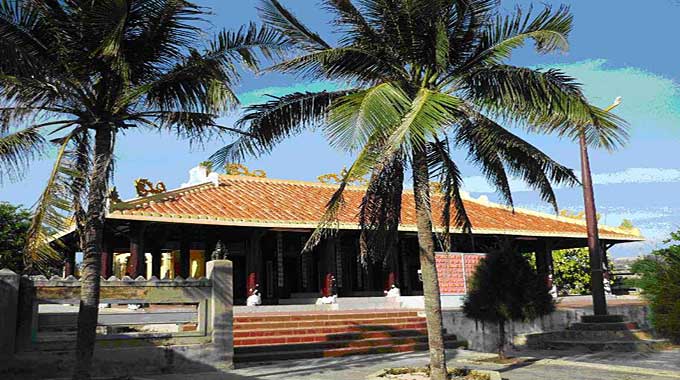Visitors to Phu Quy Island can’t miss Van An Thanh temple, one of the two famous temples to the Whale God in Binh Thuan province.

Situated in a white sandy beach in an old fishing village, Van An Thanh temple was built in 1781 to worship the Whale God. Other sea gods, such as Thuy Long Thanh Phi Goddess, the Hi Hoang Thai Hieu Tien Su God, and the Dragon God and some locals who made great contribution to the establishment of the village are also worshipped here.
At the beginning, Van An Thanh was just a tiny and humble chamber. In 1841, there was a giant whale found dead on the shore near Van An Thanh. He was then buried in the cemetery of the temple by villagers in very sacred and grand rituals and ceremonies. It was the first and the biggest whale had been found in this village, therefore, he was regarded as the “Great Lord Whale”. Every Oct 10 of the Lunar calendar (the day Great Lord Whale was found), a festival is held in the temple attracting thousands of locals and visitors. During the festival, rituals and ceremonies are hold to show the gratitude of locals to the gods as well as their wish for a lucky and prosperous year ahead.
Facing towards the South and in view of the sea, Van An Thanh has the architecture style that follows closely to the traditional style of houses and temples in southern central Viet Nam. The temple is home to over 100 sets of sea-creature’s skeletons including whales, dolphins, turtles etc. which are worshipped respectfully by the locals. The most impressive, undoubtedly is the set of Great Lord Whale which is 17 meter long. This is the second largest intact whale skeleton in Binh Thuan.
Van An Thanh temple was granted 10 titles by the kings of Nguyen Dynasty (from 1802 to 1945), including King Tu Duc, King Dong Khanh and King Khai Dinh. According the local legend, during the war against Tay Son Dynasty, many generals and soldiers of Nguyen Lord were rescued by the whales while traveling on the sea.
In Viet Nam, whales are often believed to bring luck, safety and prosperity for fishermen and their families. In many coastal villages, whenever a dead whale drifting in, he will be buried and mourned by thousands of locals. After three years, his bones will be exhumed to be displayed with other whales, dolphins and sea-turtles’ remains and worshipped in a whale temple near where he was found.